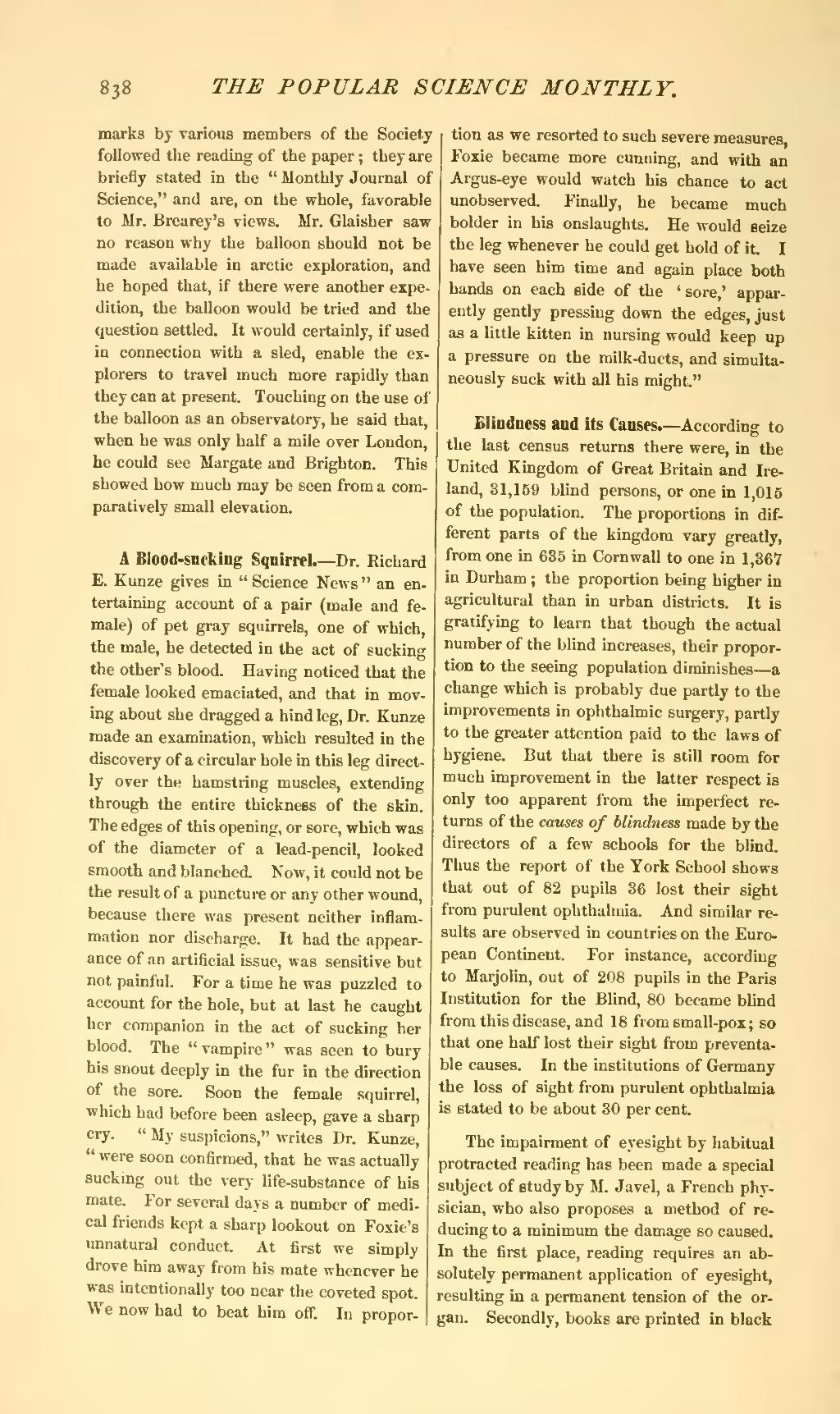marks by various members of the Society followed the reading of the paper; they are briefly stated in the "Monthly Journal of Science," and are, on the whole, favorable to Mr. Brearey's views. Mr. Glaisher saw no reason why the balloon should not be made available in arctic exploration, and he hoped that, if there were another expedition, the balloon would be tried and the question settled. It would certainly, if used in connection with a sled, enable the explorers to travel much more rapidly than they can at present. Touching on the use of the balloon as an observatory, he said that, when he was only half a mile over London, he could see Margate and Brighton. This showed how much may be seen from a comparatively small elevation.
A Blood-sucking Squirrel.—Dr. Richard E. Kunze gives in "Science News" an entertaining account of a pair (male and female) of pet gray squirrels, one of which, the male, he detected in the act of sucking the other's blood. Having noticed that the female looked emaciated, and that in moving about she dragged a hind leg, Dr. Kunze made an examination, which resulted in the discovery of a circular hole in this leg directly over the hamstring muscles, extending through the entire thickness of the skin. The edges of this opening, or sore, which was of the diameter of a lead-pencil, looked smooth and blanched. Now, it could not be the result of a puncture or any other wound, because there was present neither inflammation nor discharge. It had the appearance of an artificial issue, was sensitive but not painful. For a time he was puzzled to account for the hole, but at last he caught her companion in the act of sucking her blood. The "vampire" was seen to bury his snout deeply in the fur in the direction of the sore. Soon the female squirrel, which had before been asleep, gave a sharp cry. "My suspicions," writes Dr. Kunze, "were soon confirmed, that he was actually sucking out the very life-substance of his mate. For several days a number of medical friends kept a sharp lookout on Foxie's unnatural conduct. At first we simply drove him away from his mate whenever he was intentionally too near the coveted spot. We now had to beat him off. In proportion as we resorted to such severe measures, Foxie became more cunning, and with an Argus-eye would watch his chance to act unobserved. Finally, he became much bolder in his onslaughts. He would seize the leg whenever he could get hold of it. I have seen him time and again place both hands on each side of the 'sore,' apparently gently pressing down the edges, just as a little kitten in nursing would keep up a pressure on the milk-ducts, and simultaneously suck with all his might."
Blindness and its Causes.—According to the last census returns there were, in the United Kingdom of Great Britain and Ireland, 31,159 blind persons, or one in 1,015 of the population. The proportions in different parts of the kingdom vary greatly, from one in 635 in Cornwall to one in 1,367 in Durham; the proportion being higher in agricultural than in urban districts. It is gratifying to learn that though the actual number of the blind increases, their proportion to the seeing population diminishes—a change which is probably due partly to the improvements in ophthalmic surgery, partly to the greater attention paid to the laws of hygiene. But that there is still room for much improvement in the latter respect is only too apparent from the imperfect returns of the causes of blindness made by the directors of a few schools for the blind. Thus the report of the York School shows that out of 82 pupils 36 lost their sight from purulent ophthalmia. And similar results are observed in countries on the European Continent. For instance, according to Marjolin, out of 208 pupils in the Paris Institution for the Blind, 80 became blind from this disease, and 18 from small-pox; so that one half lost their sight from preventable causes. In the institutions of Germany the loss of sight from purulent ophthalmia is stated to be about 30 per cent.
The impairment of eyesight by habitual protracted reading has been made a special subject of study by M. Javel, a French physician, who also proposes a method of reducing to a minimum the damage so caused. In the first place, reading requires an absolutely permanent application of eyesight, resulting in a permanent tension of the organ. Secondly, books are printed in black
